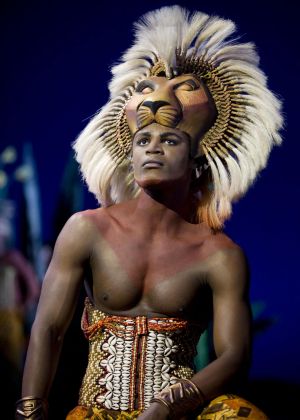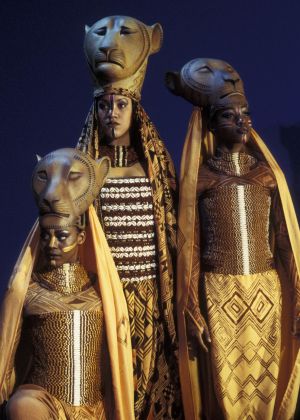|
We all know about these small cowry shells, Cypraea moneta and Cypraea annulus and their use as money and most members will know of many other past and present day uses. Towards the end of last year Celia Pain and myself watched a really fantastic and beautiful production of the Lion King at the Lyceum theatre, Covent Garden, London. The costumes and make up were the most original and imaginative that I have ever seen in a theatre production. But what we noticed more than anything else was that the costumes of the Lion King himself, the Lion Queen and their cub were covered in these little cowry shells in a series of very attractive and artistic designs and patterns (see Fig.1 and 2).
It reminded me of the ancient African tribal regalia worn for religious, royal and other purposes. The costumes, masks and puppets I found out afterwards, were designed by Julie Taymor and Michael Curry and the whole production was directed by Julie Taymor herself. To me it was quite obvious why the play has already run for 10 years and will probably run for another ten or more and I would encourage anyone who hasn’t seen it to do so.
These ceremonial clothes, costumes and the headdresses are still made and used by African tribes for displays put on especially for tourists and high ranking visitors. Illustrated is a Mali headdress Fig.2 (in my collection).
This was a fascinating modern use of these little cowry shells.
AcknowledgementsThe reference and the pictures (Fig.1 and 2) of costumes from the Lion King were kindly sent to me by Ryan Petersen of The Corner shop PR, the press representative for Disney’s The Lion King and are reporoduced here with permission.
ReferenceNational Geographic March 1969 Vol.135, No.3. P.430.
|
|
The Lion King - a modern use of money cowries
Issue
22
Page
28

 Figure 1: Andile Gumbi as the Lion King (from the London Company.)
Figure 1: Andile Gumbi as the Lion King (from the London Company.) Figure 2: The Lionesses in the London production of Disney's The Lion King)
Figure 2: The Lionesses in the London production of Disney's The Lion King)